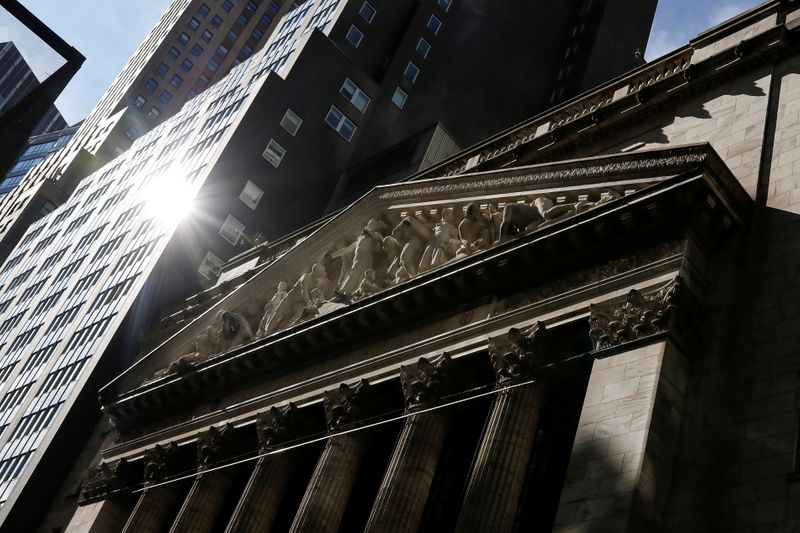By Herbert Lash
(Reuters) -U.S. stocks rallied on Friday, driving the S&P 500 to a near-record closing high, after factory data and new home sales underscored a booming economy while megacap stocks rose in anticipation of strong earnings reports next week.
The bounceback follows a sell-off on Thursday when reports that U.S. President Joe Biden plans to almost double the capital gains tax spooked investors. Analysts dismissed the slide as a knee-jerk reaction and pointed to the strong outlook.
As the three major Wall Street indexes surged, the CBOE market volatility or "fear" index plunged almost 10% in a sign of tumbling investor anxiety about the risks ahead.
Companies are providing guidance after staying quiet during the pandemic, while lower bond yields and results that beat estimates are driving the rally, said Tim Ghriskey, chief investment strategist at Inverness Counsel in New York.
"There is a lot of anticipation of what's to come," he said. "We've seen actual reports beating these very high expectations. Yields have come back down, which is very positive for tech."
Earnings take center stage next week when 40% of the S&P 500's market cap report on Tuesday through Thursday, including the tech and related heavyweights of Microsoft Corp (NASDAQ:MSFT), Google parent Alphabet (NASDAQ:GOOGL) Inc, Apple Inc (NASDAQ:AAPL) and Facebook Inc (NASDAQ:FB).
Those names, including Amazon.com Inc (NASDAQ:AMZN), supplied the biggest upside to a broad-based rally in which advancing shares easily outpaced decliners.
Expectations for company results have steadily gained in recent weeks as opposed to a typical decline as earnings season approaches. First-quarter earnings are expected to jump 33.9% from a year ago, the highest quarterly rate since the fourth quarter of 2010, according to IBES Refinitiv data.
U.S. factory activity powered ahead in early April. IHS Markit's flash U.S. manufacturing PMI increased to 60.6 in the first half of this month, the highest reading since the series started in May 2007.
In another sign of strong consumer demand, sales of new U.S. single-family homes rebounded more than expected in March, likely boosted by an acute shortage of previously owned houses on the market.
All the 11 major S&P 500 sectors were higher, with technology and financials leading gains.
Ron Temple, head of U.S. equity at Lazard (NYSE:LAZ) Asset Management, said the U.S. economy is about to post the strongest growth in 50 years, with more than 6% gains both this year and next.
The Federal Reserve will allow the economy to run hotter than in the past, adding to the high-growth outlook.
"Investors are gradually coming around to the sheer magnitude of excess savings, pent-up demand and the implications of such a massive wave of fiscal stimulus," Temple said.
Stocks surged just before the bell, with the benchmark S&P 500 falling a bit to miss setting a record close.
The Dow Jones Industrial Average rose 0.67% to 34,043.49 and the S&P 500 gained 1.09% at 4,180.17, just below its previous closing high of 4,185.47 on April 16. The Nasdaq Composite added 1.44% at 14,016.81.
For the week, the S&P 500 unofficially fell 0.13%, the Dow about 0.46% and the Nasdaq 0.25%.
Some earnings reports on Friday were lackluster, with American Express Co (NYSE:AXP) sliding 1.9% after reporting a slump in credit spending and lower quarterly revenue.
Honeywell International (NYSE:HON) fell 2.1% after missing revenue expectations in aerospace, its biggest business segment.
Naked Brand Group jumped 4.8% after shareholders approved the proposed divestiture of the company's Bendon brick-and-mortar operations.
Image sharing company Pinterest (NYSE:PINS) Inc gained 4.2% as Credit Suisse (SIX:CSGN) raised its price target, saying newer product offerings and expanding footprint in markets abroad will yield higher revenue and user growth.

Advancing issues outnumbered declining ones on the NYSE by a 3.62-to-1 ratio; on Nasdaq, a 2.82-to-1 ratio favored advancers.
The S&P 500 posted 81 new 52-week highs and no new lows; the Nasdaq Composite recorded 111 new highs and 20 new lows.